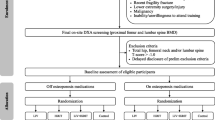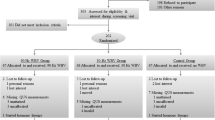Abstract
Universally safe and effective methods of mechanically loading the skeleton to improve strength and prevent fracture have yet to be identified. To be osteogenic, mechanical strains must either be of substantial magnitude or applied at high frequency (>15 Hz). High-magnitude loads place frail bones at risk of fracture. Active loading can rarely be achieved at a frequency faster than 2–3 Hz. A 12-month, uncontrolled, prospective, pilot intervention trial was conducted with five premenopausal Caucasian women with low bone mass. Subjects stood on a vibrating platform (Optimass model 1000 Mechanical Strain Device) and received a 0.2-g stimulus at 30 Hz, 2 × 10 min/day, for 12 months. Bone mineral density (BMD) was measured at the whole body, lumbar spine, proximal femora (PF), and distal radius at baseline and 6 and 12 months by DXA (Hologic QDR-1000/W). Blood and urine were collected at baseline and 3, 6, 9 and 12 months for markers of bone resorption and formation. A mean percent BMD increase of 2.03% ± 0.33% (P < 0.02) was detected at the non-dominant PF after 12 months. Trends for increases were observed at all other sites with the exception of the dominant PF. No uniform trends were observed in bone resorption and formation markers. One subject, on Fosamax, increased BMD by 6% at the lumbar spine and 4.4% at the distal radius. Preliminary findings provide evidence of a possible positive response of regions of low bone mass to brief daily bouts of in-home, passive, noninvasive, low-strain, high-frequency, mechanical loading.
Similar content being viewed by others
References
C Rubin AS Turner C Mallinckrodt C Jerome K McLeod S Bain (2002) ArticleTitleMechanical strain, induced noninvasively in the high-frequency domain, is anabolic to cancellous bone, but not cortical bone Bone (NY) 30 445–452 Occurrence Handle1:STN:280:DC%2BD387otVegsg%3D%3D
CH Turner T Yoshikawa MR Forwood TC Sun DB Burr (1995) ArticleTitleHigh frequency components of bone strain in dogs measured during various activities J Biomech 28 39–44 Occurrence Handle7852440 Occurrence Handle1:STN:280:ByqC2MrksFE%3D Occurrence Handle10.1016/0021-9290(95)80005-0
S Torvinen P Kannus H Sievanen TA Jarvinen M Pasanen S Kontulainen A Nenonen TL Jarvinen T Paakkala M Jarvinen I Vuori (2003) ArticleTitleEffect of 8-month vertical whole body vibration on bone, muscle performance, and body balance: A randomized controlled study J Bone Miner Res 18 876–884 Occurrence Handle12733727 Occurrence Handle10.1359/jbmr.2003.18.5.876
C Rubin R Recker D Cullen J Ryaby J McCabe K McLeod (2004) ArticleTitlePrevention of postmenopausal bone loss by a low-magnitude, high-frequency mechanical stimuli: a clinical trial assessing compliance, efficacy, and safety J Bone Miner Res 19 343–351 Occurrence Handle15040821 Occurrence Handle10.1359/JBMR.0301251
SM Verschueren M Roelants C Delecluse S Swinnen D Vanderschueren S Boonen (2004) ArticleTitleEffect of 6-month whole body vibration training on hip density, muscle strength, and postural control in postmenopausal women: a randomized controlled pilot study J Bone Miner Res 19 352–359 Occurrence Handle15040822 Occurrence Handle10.1359/JBMR.0301245
C Rubin M Pope JC Fritton M Magnusson T Hansson K McLeod (2003) ArticleTitleTransmissibility of 15-hertz to 35-hertz vibrations to the human hip and lumbar spine: determining the physiologic feasibility of delivering low-level anabolic mechanical stimuli to skeletal regions at greatest risk of fracture because of osteoporosis Spine 28 2621–2627 Occurrence Handle14652479 Occurrence Handle10.1097/01.BRS.0000102682.61791.C9
KM Winters-Stone CM Snow (2003) ArticleTitleMusculoskeletal response to exercise is greatest in women with low initial values Med Sci Sports Exerc 35 1691–1696 Occurrence Handle14523306 Occurrence Handle10.1249/01.MSS.0000089338.66054.A5
Author information
Authors and Affiliations
Corresponding author
About this article
Cite this article
Beck, B., Kent, K., Holloway, L. et al. Novel, high-frequency, low-strain mechanical loading for premenopausal women with low bone mass: early findings. J Bone Miner Metab 24, 505–507 (2006). https://doi.org/10.1007/s00774-006-0717-9
Received:
Accepted:
Issue Date:
DOI: https://doi.org/10.1007/s00774-006-0717-9




